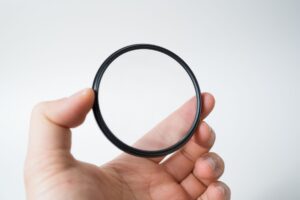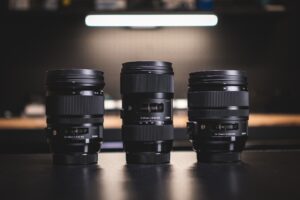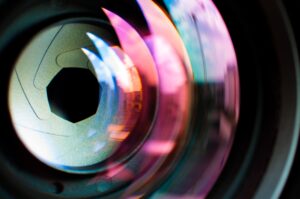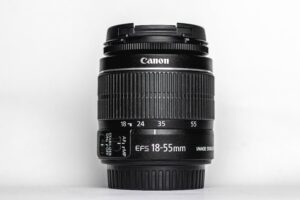In photography, the question often arises: Are camera lenses concave or convex? The short answer is that they can be both, depending on their design and intended purpose.
This seemingly simple distinction plays a crucial role in determining how a lens captures light and, subsequently, the resulting image.
By grasping these foundational lens concepts, photographers can make more informed decisions about equipment and, ultimately, produce better photos.
So, whether you’re a novice or a seasoned professional, it’s worthwhile to delve deeper into the world of lens curvature.
The Basics of Lens Curvature
Understanding Concave Lenses
A concave lens is thinner at its center than at its edges. This design causes light rays that enter the lens to diverge or spread out. In essence, a concave lens can be visualized as a “caved-in” or “hollowed” lens.
Table: Key Characteristics of Concave Lenses
| Feature | Description |
|---|---|
| Shape | Thinner in the center, thicker at the edges |
| Light Refraction | Causes light rays to diverge or spread out |
| Focal Point | Lies in front of the lens |
| Primary Uses | Correcting nearsightedness in eyeglasses, artistic effects |
Common Photographic Scenarios
Concave lenses are less common in mainstream photography but have their niches. They can be employed for:
- Creating unique artistic effects due to their distortion.
- Adjusting beam patterns in specific flashlight or stage lighting scenarios.
- Enhancing the broad, diffuse spread of light in certain contexts.
Delving into Convex Lenses
A convex lens is the opposite of its concave counterpart; it’s thicker in the center and thinner at the edges. Such a design allows it to converge or focus light rays that pass through it, which is why it’s often referred to as a “converging lens.”
Table: Key Characteristics of Convex Lenses
| Feature | Description |
|---|---|
| Shape | Thicker in the center, thinner at the edges |
| Light Refraction | Causes light rays to converge or focus |
| Focal Point | Lies behind the lens |
| Primary Uses | Majority of camera lenses, magnifying glasses, binoculars |
Common Photographic Scenarios
Convex lenses dominate the photography world due to their ability to focus light. They are instrumental in:
- Capturing clear, sharp images across various photography genres.
- Achieving desired bokeh or background blur in portrait photography.
- Zooming into distant subjects with telephoto lenses.
Effects of Lens Curvature on Photography
Impact on Image Quality
When it comes to achieving high-quality photographs, understanding the effects of lens curvature is paramount. Each lens design impacts image outcomes in distinct ways.
Depth of Field and Bokeh Considerations
The curvature of a lens plays a pivotal role in determining the depth of field.
Convex lenses, with their ability to focus light, typically offer a shallower depth of field when combined with larger apertures. This results in those beautifully blurred backgrounds, known as bokeh, that many photographers chase.
On the other hand, concave lenses, due to their light-spreading nature, generally produce a deeper depth of field.
Influence on Aberrations
Lenses aren’t perfect. They can introduce optical aberrations—unwanted distortions in an image. Two common types influenced by lens curvature include:
- Chromatic Aberration: This occurs when different wavelengths (colors) of light are refracted by a lens to varying degrees, resulting in a sort of “color fringing” around high-contrast areas in images.
- Barrel Distortion: Often seen in wide-angle lenses, this makes straight lines appear bowed outward, giving the image a “barrel-like” appearance.
Both issues can be corrected post-production, but understanding and anticipating them is beneficial for photographers.
Focal Length and Aperture Size
A lens’s curvature heavily influences its focal length (the distance between the lens and the image sensor when the subject is in focus) and its aperture size (the diameter of the opening allowing light into the camera).
- Convex Lenses: These are versatile. They can have short focal lengths (wide-angle views) or long ones (zoomed-in views). A convex lens’s curvature affects how light converges, thus influencing its effective focal length.
- Concave Lenses: Typically not used as primary camera lenses, they may appear in more complex lens systems to correct specific aberrations or achieve certain effects.
The interplay between focal length and aperture size, shaped by lens curvature, dictates the amount of light entering the camera and the area in focus—two vital considerations for photographers.
Specific Lens Types and Their Designs
Wide-angle vs. Telephoto Lenses
At the heart of every photographer’s toolkit lie these two lens categories, each having its unique curvature characteristics.
- Wide-angle Lenses: Generally have shorter focal lengths. Their convex elements dominate, but some may incorporate concave elements to manage distortions and provide a broad field of view.
- Telephoto Lenses: These are all about zooming in. They possess longer focal lengths and, while primarily using convex elements, might also include concave ones to adjust light paths and reduce certain optical aberrations.
The Mystery of Zoom Lenses
Zoom lenses are a marvel of optical engineering. They offer variable focal lengths, letting photographers shift from wide-angle to telephoto views without swapping lenses. But how?
- Dual Nature: These lenses incorporate a blend of both concave and convex elements. As you zoom, the positions of these elements change relative to one another, adjusting the lens’s effective focal length.
- Innovation and Universality: The ingenious design of zoom lenses might lead one to ask: Are camera lenses truly universal? The principles of lens design may be constant, but the applications can vary, offering a plethora of creative possibilities for photographers.
Considerations for Photographers
Selecting the Right Lens for the Job
For photographers, the journey often starts long before pressing the shutter. The selection of the right lens is paramount to achieving the desired shot.
When to Opt for Lenses with More Concave or Convex Elements
- Concave Elements: If you’re aiming for broader, more diffuse lighting or unique artistic effects, a lens with pronounced concave elements might serve you best. However, these are rare in standard photographic applications and might be more suited for specialty photography or lighting scenarios.
- Convex Elements: The majority of photography, be it landscapes, portraits, or wildlife, leverages the focusing power of convex lenses. Their ability to converge light makes them ideal for producing sharp, clear images across a variety of scenarios.
How the Lens Type Can Affect the Desired Photography Outcome
Every lens brings with it a set of characteristics—field of view, depth of field, bokeh, and potential optical aberrations.
Understanding the interplay between concave and convex elements within a lens helps photographers anticipate the effects and craft their images more intentionally.
The Role of Camera Lens Protectors
Lenses, especially those with pronounced curvatures, are vulnerable. They’re exposed to the elements—dust, moisture, and occasional knocks.
Protecting Your Lens and Its Curvature
- A lens protector acts as a shield, minimizing direct exposure to potential hazards. While it primarily serves to protect the surface, it indirectly safeguards the lens’s curvature by preventing scratches or damages that could distort the light path.
- Beyond physical protection, some lens protectors come with coatings to reduce flares or enhance color neutrality, thereby preserving image quality.
Wondering about the real necessity of these protectors in your photography arsenal? Delve into the debate here.
FAQs
Do cameras use concave lenses?
Yes, cameras can utilize concave lenses, but often as part of a complex lens system to correct specific aberrations or achieve particular effects.
Why is a convex lens used in a camera not concave?
Convex lenses are primarily used in cameras because they converge light, creating a focused image on the sensor, making them ideal for capturing clear photos.
Why are camera lenses concave?
While the primary lens in cameras is usually convex, concave elements may be incorporated in multi-element lenses to manage distortions and provide specific optical effects.
What type of lens does a camera use?
Cameras typically use compound lenses, which are a combination of both convex and concave lens elements, designed to optimize image quality and minimize distortions.
Who uses a concave lens?
Concave lenses are commonly used by optometrists for eyeglasses to correct myopia or nearsightedness. They’re also found in optical systems like telescopes and certain camera lens setups.
Are concave mirrors used in cameras?
No, cameras typically don’t use concave mirrors. Such mirrors are more common in telescopes and other optical devices that gather and focus light.
What is the difference between concave and convex lens photography?
Concave lenses spread out light rays, leading to a broader, more diffuse focus, while convex lenses converge light rays to produce sharp, clear images.
What is an example of a concave lens?
An example of a concave lens is the type used in eyeglasses for correcting myopia, where the lens has a thinner center and thicker edges.
Do convex lenses always invert images?
Yes, a single, standalone convex lens will always invert and reverse an image. However, in most camera systems, multiple lens elements or additional optics ensure the final image is upright.
Closing Thoughts
Photography, at its core, is a beautiful interplay between art and science. The designs of lenses, with their intricate arrays of concave and convex elements, epitomize this synergy.
For photographers—whether a beginner just stepping into this world or a seasoned professional—it’s a continuous journey of discovery.
Every lens brings with it a new perspective, a fresh challenge, and an opportunity for unparalleled creativity.
So, embrace the complexities, experiment with different lenses, and witness firsthand the diverse tapestry of images you can weave with the right piece of glass.








![Read more about the article Should I Buy Used Camera Lenses? Insights, Advice & Recommendations [2023]](https://photographyexplorer.com/wp-content/uploads/2023/08/Should-I-Buy-Used-Camera-Lenses-300x200.jpg)
Pingback: The Complete Guide on How Camera Lenses Are Made - Photography Explorer